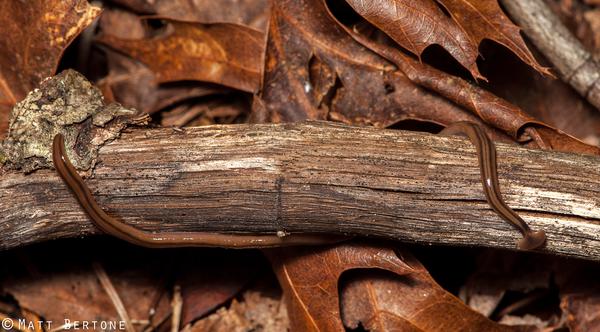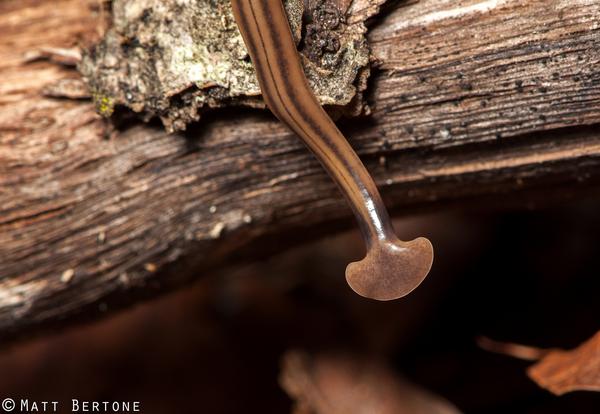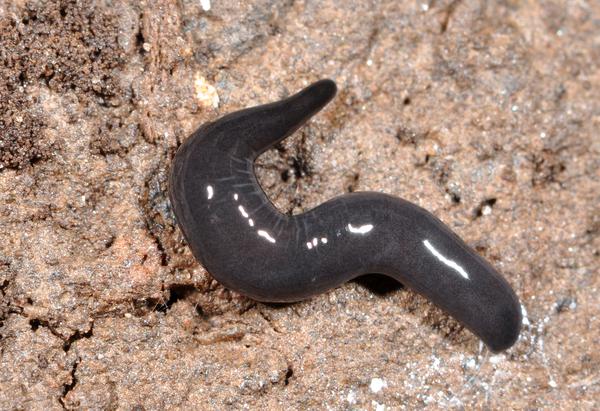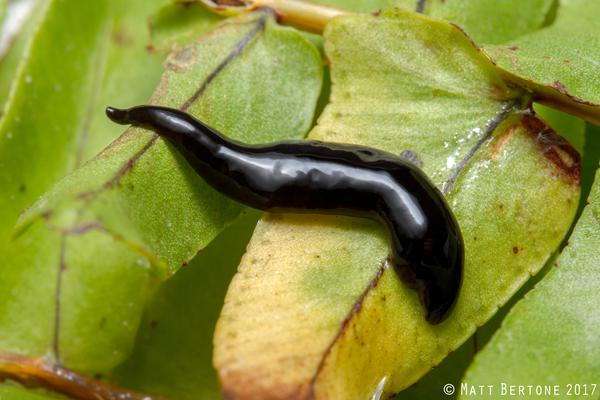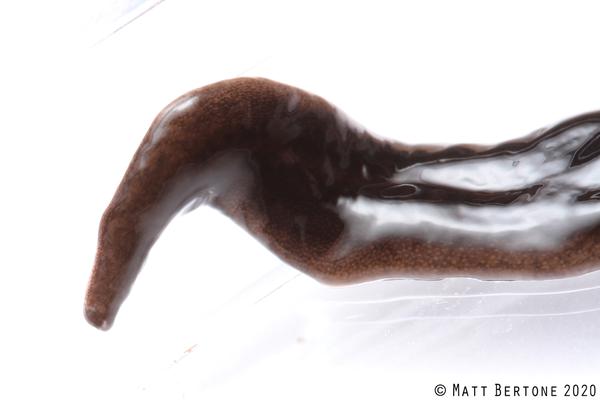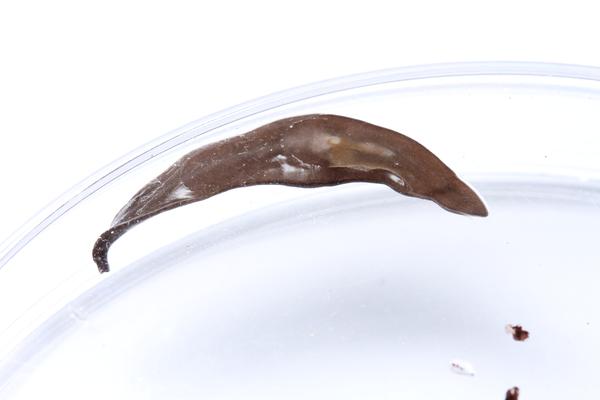Introduction
Flatworms are a diverse group of animals in the phylum Platyhelminthes. Although most are fully aquatic, there are many species that exist on land in moist, terrestrial habitats, particularly those in the family Geoplanidae. These worms are often variously called land planarians, terrestrial flatworms, or hammerhead worms (specific to a particular group; see Identification section for discussion). Terrestrial flatworms are most diverse in the tropics, especially SE Asia, Australia, Africa, and South America. Human trade and movement of items that can contain these worms (for example potted plants and soil) has aided their spread across the world. Some species are now widespread. Several species exist in North Carolina, either being native, long-established exotic species, or newly introduced species. For example, the alien-looking hammerhead worm Bipalium kewense has been in North Carolina since at least the 1950s. In recent years these worms may have increased in numbers; alternatively awareness of them has increased, possibly due to widespread use of digital cameras and the internet allowing the public to recognize these creatures more readily.
NC State University and local agencies are not currently tracking species that are already known to exist in the state, but are interested in knowing whether people encounter new species, especially non-hammerhead forms.
Identification
As their name suggests, flatworms are legless animals with a flattened appearance. They are shiny, covered in a slime-like substance that aids their movement and keeps them from drying out. Some flatworms may be confused for dark slugs, but they lack the tentacles found in slugs and do not have any texture to the body. Terrestrial flatworms vary in size, from just a few millimeters to over one foot (12”) long. Although they can stretch and contract easily, they come in a few general shapes. Some are wider in the middle and leaf-like, with pointed ends, while others are thin and elongate with a distinct crescent-shaped “hammerhead”. The leaf-like forms are typically dull gray, dark brown, blue or black (see images). Some have a lighter underside or a thin stripe down the back. Species with a hammerhead are typically orange, yellow, or brown with one to several stripes along the back (see images). There are species in the world with other patterns as well, some being very brightly colored. The presence and number of eyes can also be diagnostic for different species, some having a pair of well-developed, more obvious eyes while others have numerous small dot-like eyes around the margin of the head.
The following are some flatworms found in North Carolina, or those that are being monitored as potentially invasive species:
-
There are several species of hammerhead worms in North Carolina. Bipalium kewense (see images), is typically a darker brown color with five lines along the length of the body (the central and side lines being thinner than the others) and a dark, broken collar around the neck. The mollusc-eating hammerhead worm (Bipalium vagum), has a short body and wide head, with a single dark stripe down the back and a distinct collar around the neck. Diversibipalium multilineatum is pale or straw yellow colored, and has five thin stripes down the length of the body with the central one continuing onto the head; it also lacks a collar around the neck region. The wandering broadhead planarian (Bipalium adventitum) is light colored as well, but has a single thin stripe along the back, no collar around the neck and may have a more rounded head. The three-lined land planarian (Bipalium pennsylvanicum) has three dorsal lines, the middle line extending onto the head and lacking a collar around the neck. A good illustration of some of the differences can be seen in this drawing.
-
Several small dark gray/blue/brown species without any distinct patterns or a hammerhead are found in North Carolina (see images). Some of these may be native but are difficult to identify to a particular species. Others may be recent invaders, including the species Obama nungara, a South American species that has been found in Europe and other countries, as well as the newly described Amaga pseudobama, whose native origin is unknown (see images).
-
Among the most talked about land flatworms is the New Guinea flatworm (Platydemus manokwari). It has recently become established in many Southern states and image records show it is likely in certain parts of North Carolina now. It can be distinguished from similar dark species without a hammerhead by the distinct light stripe down the length of the back, the very pale underside (contrasting with the dark top of the animal), and a large eye on each side of the head.
Finally, it should be noted that in general identifying these flatworms to species can be difficult or impossible without dissecting their internal organs or using molecular (DNA) identification techniques. For identification purposes it’s best to take images of the top and bottom of the animal for the best chance of ID, particularly in those without a hammerhead.
To view some of the species already recorded in North Carolina, you can find records and photos on iNaturalist.
Biology
Terrestrial flatworms require moisture, so they are not found in situations that are dry. They can often be found under rocks, in leaf litter or under other debris on the ground where the environment remains humid or wet. They may be active all times of the year when the temperature is conducive.
All terrestrial flatworms are generalist predators. They feed on invertebrate organisms such as earthworms, snails, slugs, and several arthropods, including isopods, insect larvae, and springtails. Some are more specific in their diet than others. Unlike most animals, the mouth is not where you would expect: flatworms have their mouth on the underside of the body near the middle of the animal. They wrap around their prey and either digest it on the outside, sucking up the liquified contents, or they extend the tube-like mouth outside of their body to penetrate their prey.
Flatworms are hermaphrodites, having both male and female reproductive organs. Reproduction in flatworms happens in two main ways. Sexual reproduction occurs when the worms mate and lay cocoons that contain numerous young. Asexual reproduction, however, is apparently more common in many situations. This occurs when the body breaks/divides and each section becomes a new worm. This is thought to be one reason these worms become so abundant so quickly in an area in which they are introduced.
Environmental & Health Concerns
Since terrestrial flatworms are known to kill other invertebrates, especially other native worms, snails, and slugs, they have been considered damaging where they are introduced. For example, earthworms can play an important role in soil health, thus these flatworms are often seen as detrimental predators. However, the actual impact on the environment and local fauna from flatworms is complicated and little understood. Although they can reduce populations of earthworms in natural environments, it should be noted that many earthworms found commonly in North Carolina are also exotic (some introduced centuries ago), and some are even destructive to native habitats. For example, jumping worms in the genus Amynthas have been implicated in destroying leaf litter in forests, changing the native landscape. Also, given the fact that numerous species of flatworms have already been established for many years in the state, they are likely not a major concern as no direct evidence of their impact has been seen. However, their environmental impact has not been thoroughly investigated to date. There are also concerns about flatworms destroying earthworms in vermiculture (earthworm farming) and vermicomposting, but again this impact is not commonly seen.
Along with their predatory behavior, there are a few other issues with flatworms concerning human and animal health. The first is that at least two members of the hammerhead genus Bipalium (B. kewense and B. adventitum) are the first land invertebrates known to produce tetrodotoxin, the same potent toxin produced by pufferfish. This toxin is thought to help them overcome prey and also defend them and their eggs from predators. There is very little information about the toxin’s effects on humans, but it is likely minimal unless the worms are ingested in quantities. After handling these worms, it is advised to wash hands thoroughly.
The second potentially negative health aspect is that some species can carry the infective stages of the rat lungworm (Angiostrongylus cantonensis), an internal parasite. Although infections are possible if the worms are eaten, this is a very rare occurrence especially in North Carolina. Furthermore, other local snails, slugs and other invertebrates are known to carry this parasite.
Management
Eradication of terrestrial flatworm populations in the lawn and landscape can be difficult, if not impossible. To manage established populations, first and foremost it is recommended to not cut up the worms to destroy them, as cut fragments can generate a new worm from each section.
If the worm(s) can be picked up with tweezers or gloved hands, they can be killed in rubbing alcohol or put in a bag and frozen. To avoid direct contact, salt can also be used to effectively eliminate individual flatworms that are encountered around the home. If applying salt near plants, try to limit the amount applied as salt can harm vegetation. Additional management tactics that are recommended for slugs (molluscicides, traps, etc.) may be effective against various flatworm species as well, but there have been no studies to confirm that efficacy. Please note that these management strategies will also kill earthworms. If preserving an earthworm population is necessary (such as in a vermiculture operation) they will need to be removed during flatworm treatment.
Importantly, if you find a flatworm in a potted plant or any plant obtained from a nursery, try not to move or plant it without first isolating and destroying the worm(s). While the effects of these animals on the environment are assumed to be minimal, it is best to avoid moving them around if at all possible since many species are considered invasive.
Publication date: Dec. 8, 2020
N.C. Cooperative Extension prohibits discrimination and harassment regardless of age, color, disability, family and marital status, gender identity, national origin, political beliefs, race, religion, sex (including pregnancy), sexual orientation and veteran status.

